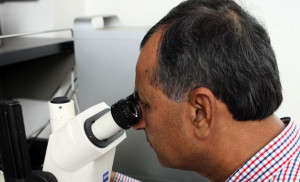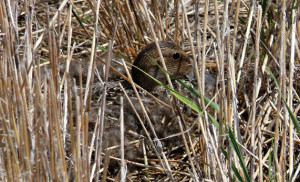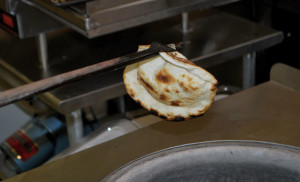Disease-fighters maintain arsenal of weapons
Gotham City has Batman and Metropolis has Superman to defend against bad guys.
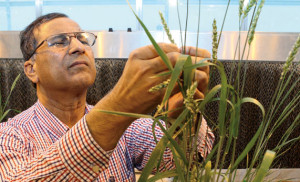
Small grains pathologist Shaukat Ali examines cultivars in the greenhouse at the Seeds Laboratory for signs of disease.
South Dakotans have a team of plant scientists at SDSU working to defend the wheat crop against devastating diseases. They’re not superheroes, but they’re close.
Randy Englund, executive director of the South Dakota Wheat Commission, credits the wheat breeders for developing varieties that can meet the challenges of the diseases and pests that South Dakota wheat farmers encounter.
Small grains pathologist Shaukat Ali doesn’t wear a cape or claim to have super powers, but he’s part of the SDSU disease-fighting team.
“It’s essential to breed any cultivar to incorporate resistance to multiple diseases,†explains Ali, citing possible yield losses ranging from 25 to 55 percent.
To be proactive in fighting wheat diseases, Ali takes leaf, head and root samples from across the state to identify the types and races of pathogens that exist.
“Every race has different genetic mechanisms of resistance,†Ali says, “so it is important to know what kind of population we have in the state.â€
Diseases can be managed with chemicals, but that method is expensive and can be tough on the environment.
“Having resistance in the variety is much better,†Ali says. Pathogens can also build up resistance to chemicals, like human infections that become resistant to antibiotics.
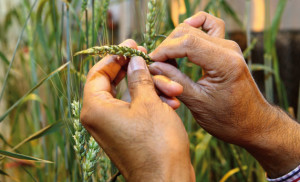
To keep on top of the bacteria and fungi active in South Dakota grains, pathologist Shaukat Ali takes leaf and root samples from locations across the state.
Vanquishing invaders
Fusarium head blight, also known as scab, was once devastating and tough to manage. “We now have a good handle on the disease,†Ali says, because of the discovery of resistant genes, which were then incorporated into the cultivars.
Englund says the Hessian fly once caused significant damage to crops, but has been largely overcome through the breeding program, which the South Dakota Wheat Commission supports through the farmer-funded checkoff system.
Maintaining disease resistance requires constant vigilance and breeders working hand-in-hand with the pathologist, Ali says. “It’s a continuous struggle.â€
Predicting outbreaks
Within the next year, Ali hopes to have another important weapon in his disease-fighting arsenal, a small-grain disease forecasting system. Developed at North
Dakota State University, the system predicts when conditions are conducive for four major diseases – tan spot, leaf blotch, leaf rust and head blight.
Using this early warning system, farmers can anticipate outbreaks of disease, Ali says. They can spray fungicides to manage disease, giving them an additional eight to 10 bushels per acre, more than enough to pay for the treatment.
Ali is the expert when it comes to bacteria and fungi, but professor Marie Langham of the plant science department oversees virus resistance. The chief virus that affects wheat in South Dakota is wheat streak mosaic.
The virus affects mainly winter wheat, and the earlier the crop is planted, the greater its chance of developing the disease, Langham explains. During the last 20 years, the breeders have increased the number of varieties that can resist or tolerate wheat streak.
Capturing future culprits
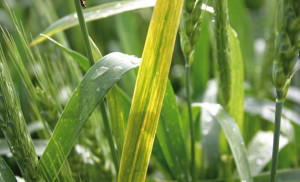
Yellowing of the leaves on Alice, a variety of hard white wheat, is a telltale sign of wheat streak mosaic, a virus that affects wheat in South Dakota.
A new race of stem rust called Ug99 and its variants have attacked wheat in Africa but have not yet reached North America. “We need to be prepared,†says doctoral student Rosa Guerrero-Chavez. An estimated 90 percent of the varieties in South Dakota are susceptible to the disease, which attacks spring wheat. Her advisers are professor Karl Glover and associate professor Jose Gonzalez of plant science.
Collaborating with U.S. Department of Agriculture researchers in St. Paul, Minn., the team has discovered a line of South Dakota wheat with moderate resistance to Ug99. They are now genetically mapping a cross between this line and the Brick variety to determine which genes account for the resistance, Guerrero-Chavez explains.
These heroic efforts will help defend the wheat crop against threats so South Dakota farmers can continue to feed a growing world population.
Christie Delfanian
Molecular biologist developing drought-tolerant wheat
Coming one day to South Dakota cropland — drought-tolerant wheat.

Graduate student Manali Shirke prepares the immature embryos for her wheat-transformation experiments as part of the effort to develop drought-tolerant lines for South Dakota farmers.
This is the goal of molecular cell biologist Jai Rohila. To do this, the assistant professor of biology and microbiology has obtained drought- and heat-tolerant germplasm through collaboration with Alexandria University in Egypt.
Rohila and his team of two graduate students and two undergraduate students are comparing the genetic makeup of the Egyptian germplasm and that of South Dakota wheat, he says, “to discover the genes for drought and heat tolerance.â€
Once Rohila accomplishes this task, spring wheat breeder Karl Glover will cross the Egyptian germplasm with South Dakota wheat varieties and then screen for those functional gene and protein markers. The breeding process will take from six to 10 years.
“By doing that,†Glover says, “I can create germplasm that should theoretically be as resistant to drought as what he’s identified — developed in and for South Dakota.â€
Winter wheat provides waterfowl habitat
Farmers and waterfowl don’t always get along. But SDSU wheat breeders, Bayer Cropscience and Ducks Unlimited have joined forces to keep peace in the fields and expand waterfowl habitat through planting more winter wheat.
The Winter Cereals: Sustainability in Action project seeks to expand wildlife habitat in the Prairie Pothole Region, which extends from Iowa across the Dakotas into Canada. This area supports more than half of North American waterfowl, yet habitat acres have decreased significantly over the last decade.
According to Blake Vander Vorst, senior agronomist for Ducks Unlimited Great Plains Office, the chance of waterfowl having a hatched nest is 24 times higher in winter cereals than in spring-planted crops.
Through this program, Bayer wants to develop better cold tolerance in its winter wheat, according to Geoff Kneen, the company’s head of strategic initiatives and Research Triangle Park operations in North Carolina.
“Bayer is also looking at how our technologies fit into a sustainable crop production program,†says Director of Stakeholder Relations/Stewardship Alan Ayers.
All this will help farmers and waterfowl cultivate a productive relationship.
Cereal chemist evaluates end product
Breeders talk genetics and germplasm, and wheat farmers talk more bushels per acre, but in the end, it all comes down to taste.
“If people don’t eat it, the sale doesn’t get made,†says professor Padu Krishnan of health and nutritional sciences.
During the last 10 years, the cereal chemist has built a state-of-the-art lab to evaluate the consumption quality of the end product. Krishnan and his team of four graduate students screen 25 to 30 varieties of wheat each year.
One variety might make better tortillas, and another better cookies; however, the goal is versatility, Krishnan explains.
“Varieties also interact with the environment within nature,†Krishnan says, so wheat from one year may have a different taste and functionality than that of the previous year.
The current movement toward whole grains and the new federal dietary guidelines make Krishnan’s work even more valuable to producers, according to Randy Englund, executive director of the South Dakota Wheat Commission.
“Advances at all stages of the production chain are driven largely by research findings,†Englund says. The wheat commission has supported the SDSU wheat breeding program through its checkoff system for the last 50 years.

